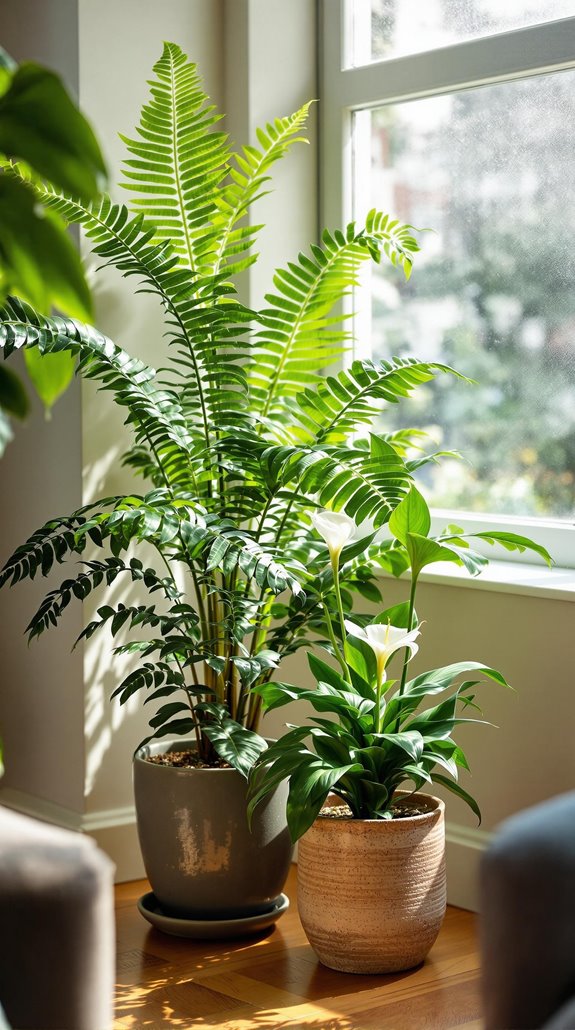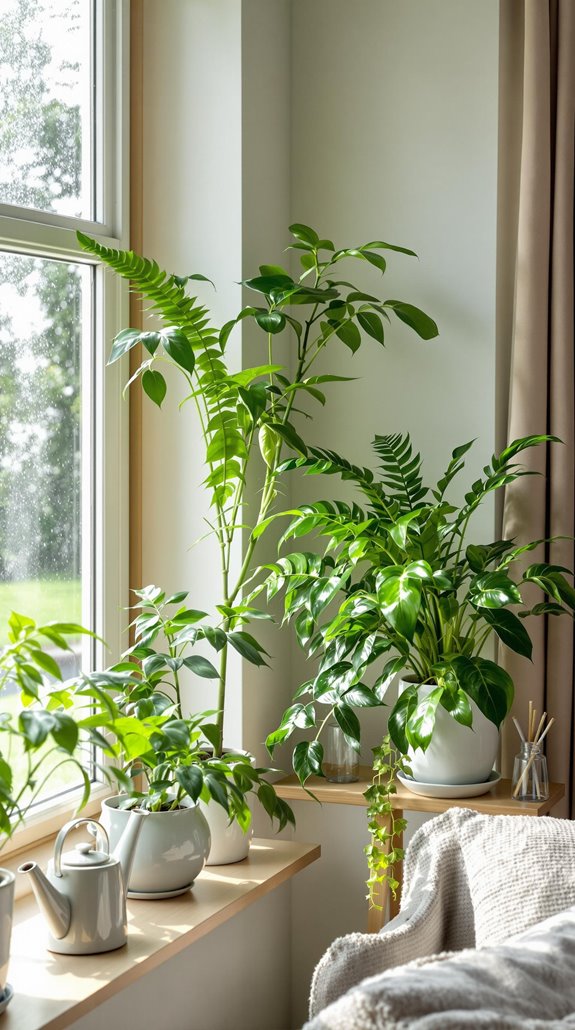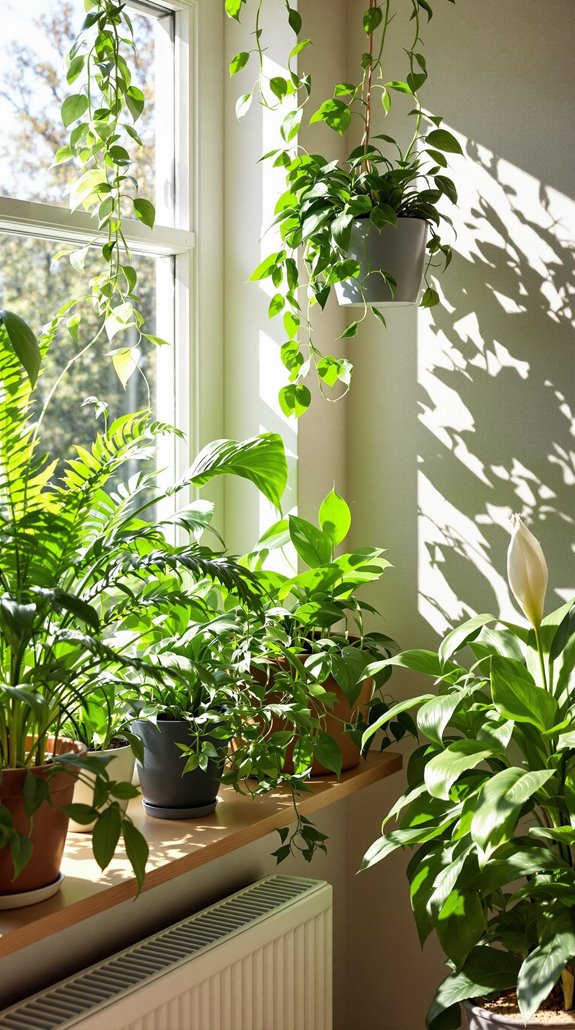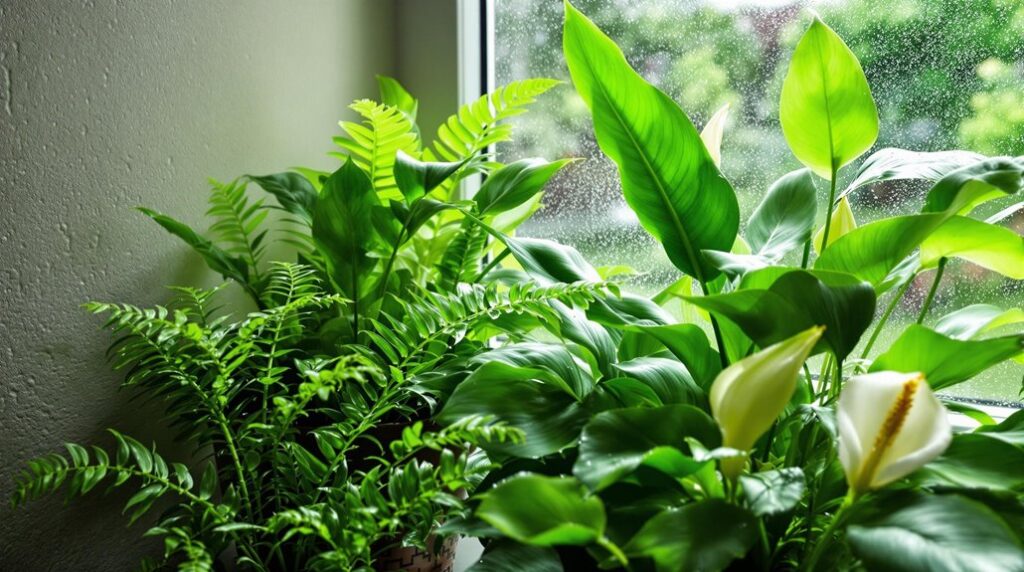I’ve discovered that certain houseplants can markedly reduce condensation in UK homes, acting as natural dehumidifiers that outperform many conventional methods. After testing various species in my own damp-prone property, I’ve identified specific plants that absorb moisture while thriving in our humid climate. The key isn’t just choosing the right varieties—it’s understanding their placement, care requirements, and how they integrate with your existing ventilation strategy to create a thorough solution.
Key Takeaways
- English Ivy and Peace Lilies effectively absorb moisture while filtering air toxins in UK homes.
- Boston Ferns excel in bathrooms and steamy rooms, naturally absorbing significant ambient moisture levels.
- Spider Plants require minimal maintenance yet eliminate up to 90% of air toxins within 48 hours.
- Plants regulate humidity through stomata and transpiration, preventing condensation formation at dew points naturally.
- Position moisture-absorbing plants near windows and cluster multiple species for maximum condensation reduction impact.
Best Moisture-Absorbing Plants for UK Homes

When condensation becomes a persistent problem in UK homes, moisture-absorbing plants offer a natural solution that combines functionality with aesthetic appeal. I’ve found that English Ivy works exceptionally well, trapping moisture through its numerous leaves while filtering harmful toxins like formaldehyde. For bathrooms, Peace Lilies excel in low-light conditions, absorbing ambient moisture and combating mould growth effectively.
Boston Ferns are my go-to choice for steamy rooms, as their dense fronds absorb significant moisture and reduce window condensation. Spider Plants provide reliable humidity control with minimal maintenance, making them perfect for busy households. These plants can eliminate up to 90% of air toxins within just 48 hours, making them powerful allies against indoor air pollution. Orchids naturally absorb moisture through aerial roots, thriving in humid environments while adding decorative appeal. Each plant addresses specific moisture challenges while improving your home’s air quality.
How Plants Naturally Combat Condensation Problems
Understanding which plants absorb moisture effectively is only part of the equation—the real power lies in how these plants naturally combat condensation at the cellular level. I’ve discovered that plants use biomolecular condensates to sequester proteins like FRI and ARF19, which directly respond to humidity changes in your home. These condensates increase local concentrations of moisture-detecting molecules, accelerating your plant’s response to dampness.
What’s fascinating is how plants like Boston Ferns and Peace Lilies don’t just absorb water vapor—they actively prevent condensation formation by maintaining ideal humidity levels around their foliage. Their high-transpiration leaves create air movement that eliminates dew points, while their stomata continuously regulate atmospheric moisture. These condensates can exist in liquid-, gel-, or solid-like states depending on environmental conditions, allowing plants to adapt their moisture management strategies. This natural process stops condensation before it becomes problematic, making these plants your most effective allies against dampness.
Strategic Placement and Care for Maximum Results

Although plants naturally combat condensation through biological processes, their effectiveness depends entirely on strategic placement and proper care. I’ll position Boston ferns in high-humidity zones like bathrooms where condensation accumulates, while placing areca palms near damp-affected spaces to leverage their humidity-regulating properties. For English ivy, I’ll use hanging baskets near windows to maximize leaf exposure whilst keeping them away from pets due to toxicity. Introducing plants can be a part of a broader strategy to reduce energy bills by improving your home’s insulation and air quality.
I’ll provide bright, indirect light for ivy and filtered sunlight for ferns, avoiding direct harsh rays. Monthly health assessments using hygrometers help me measure humidity reduction and identify ideal placements. Well-drained soil prevents waterlogging, and I’ll test moisture levels before watering. Plants complement dehumidifiers and ventilation but cannot fully replace mechanical moisture control methods for comprehensive condensation management. Regular maintenance includes trimming dead ivy leaves monthly and misting fern fronds twice weekly for maximum moisture absorption.
Comparing Plant Solutions to Traditional Damp Methods
Plants offer a gentler, more sustainable approach to moisture control than mechanical solutions, yet their effectiveness differs markedly from traditional methods. I’ve found that dehumidifiers can extract 10-20 litres daily, while even moisture-loving plants like Boston ferns or peace lilies absorb only modest amounts through transpiration. However, you’re getting additional benefits I value: improved air quality, natural aesthetics, and zero running costs after initial purchase. It’s worth noting that increased energy consumption can be a significant drawback of mechanical solutions like dehumidifiers.
Traditional methods like extractor fans provide immediate results but create noise and consume energy continuously. Plants work silently, requiring only basic care. While they won’t replace mechanical systems in severe damp conditions, they excel as complementary solutions in bedrooms, bathrooms, and living spaces where you want natural moisture regulation without the industrial feel of traditional equipment. The snake plant stands out as particularly hardy succulent that tolerates low light conditions while effectively managing moisture levels.
Maximizing Your Indoor Plant Condensation Strategy

Once you’ve decided to incorporate plants into your moisture control approach, strategic implementation becomes essential for achieving measurable results. I’ll position your humidity-absorbing plants near condensation-prone windows and damp corners where they’ll work most effectively. You’ll want to elevate plants using stands to maximize their proximity to window condensation points, whilst clustering multiple species amplifies their collective moisture-reduction impact.
I recommend prioritizing bathrooms and kitchens for English Ivy and Peace Lily, as they’re naturally adapted to high-humidity environments. You’ll need to maintain adequate spacing between plants to guarantee proper airflow and light penetration. I’d suggest monitoring humidity levels with hygrometers, allowing you to adjust plant placement or density proactively. Remember that overwatering plants can actually increase indoor humidity levels, counteracting their natural moisture-absorbing benefits. This systematic approach transforms your home into a naturally balanced, moisture-controlled environment that fellow plant enthusiasts will admire.
Conclusion
I’ve shown you how moisture-absorbing plants can transform your damp UK home into a healthier environment. You’ll get the best results by choosing proven varieties like English Ivy and Peace Lilies, then positioning them strategically in high-humidity areas. Don’t forget to maintain proper care routines and monitor their effectiveness. This natural approach won’t just tackle condensation—it’ll improve your air quality while adding visual appeal to your living space.
References
- https://forum.bcss.org.uk/viewtopic.php?t=144139
- https://www.everest.co.uk/energy-efficiency/plants-for-condensation/
- https://www.whitakersgardencentre.co.uk/blogs/news/best-indoor-houseplants-to-combat-condensation
- https://manchesterwindowfactory.co.uk/6-indoor-plants-to-reduce-window-condensation/
- https://www.mirashowers.co.uk/blog/trends/bathroom-plants-that-absorb-moisture
- https://www.homebuilding.co.uk/advice/bathroom-plants-that-absorb-moisture
- https://pmc.ncbi.nlm.nih.gov/articles/PMC10473230/
- https://growerssolution.com/blogs/growers-learning-center/lets-have-a-conversation-about-condensation
- https://www.umass.edu/agriculture-food-environment/greenhouse-floriculture/fact-sheets/reducing-humidity-in-greenhouse
- https://jayscotts.com/blog/plants-that-dehumidify/

